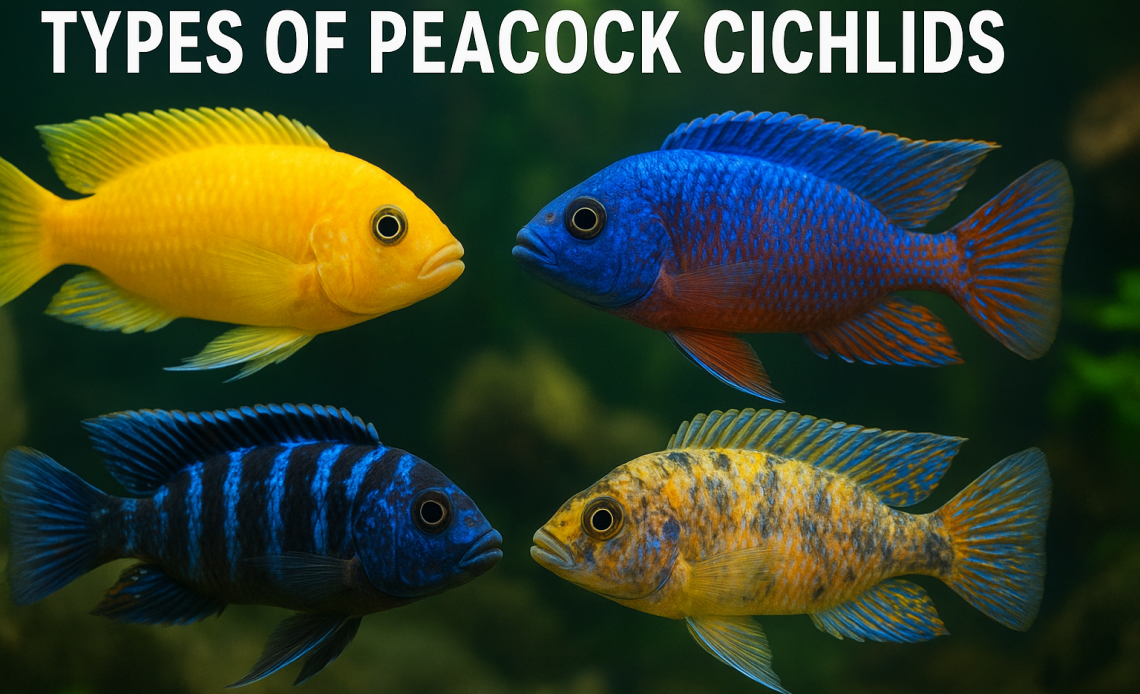Peacock cichlids are likely the most colorful and desirable freshwater fish available to the aquarium hobbyist. With their iridescent colors, docile nature (for a cichlid!) and intriguing behavior, they’re a hit with hobbyists of all levels.
But few hobbyists realize that there are dozens of peacock cichlid varieties, with their own coloration, temperament, and place of origin.
Throughout this ultimate guide, we will be going in-depth through the various peacock cichlids, ranging from the most widespread to the most unusual, to assist you in establishing and selecting the ideal one for your tank.
Whether you are just starting out with aquariums or are eager to move into more exotic breeds, this blog will walk you through all types of peacock cichlids: complete with thorough care notes and the appeal each presents to your aquatic world.
What Are Peacock Cichlids?
Peacock cichlids (Aulonocara spp.) belong to the African cichlid genera that are native to Lake Malawi. Although unlike their combatant relatives, these fish are quite peaceful and suitable for a community tank as long as they’re well cared for.
- Scientific genus: Aulonocara
- Origin: Lake Malawi, East Africa
- Size: 4 to 6 inches (they can grow even larger)
- Lifespan: 6–10 years
- Behavior: Territorial but less aggressive than other cichlids
- Tank requirement: 55+ gallons recommended
What Colors Are Peacock Cichlids?
Maybe the most intriguing characteristic of peacock cichlids is that they exist in such a variety of colors. They are usually iridescent with blues, reds, yellows, and oranges: even two colors in some instances. Some popular color varieties are:
- Electric Blue
- Sunshine Yellow
- Dragon Blood Red
- Albino (Pearl White or Pink shades)
- OB Peacock Cichlid (OB)
- Firefish (Deep red-orange blend)
- Ruby Red
- Midnight Blue
- Turquoise
- Sulfurhead
These color types often help enthusiasts identify different types of peacock cichlids by color, especially when pairing fish in community tanks.
We’ll be creating detailed guides on each color variation separately.
Popular Types of Peacock Cichlids (with Features)
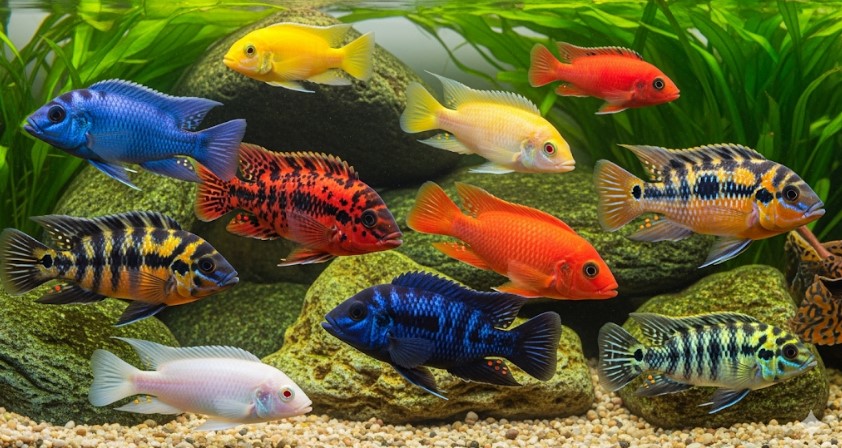
Now let’s explore the most popular types of peacock cichlids and what makes each one special:
1. Electric Blue Peacock Cichlid
- Color: Vibrant, metallic blue
- Behavior: Active swimmer; moderately peaceful
- Recommended for: Medium to large tanks with rock decoration
- Notes: One of the most beautiful beginner types
2. Dragon Blood Peacock
- Color: Rich red with speckles or blotches
- Behavior: May be slightly more aggressive
- Tankmates: Select non-aggressive cichlids
- Notes: Not a naturally occurring species; selectively bred
3. Sunshine Peacock
- Color: Bright yellow body, possibly with blue highlights
- Compatibility: Very good with peaceful tankmates
- Tank Size: Minimum 55 gallons
- Notes: Brings bold contrast to a planted tank
4. Firefish Peacock
- Color: Blazing combination of red, orange, and occasionally yellow
- Behavior: Calm if not overpopulated
- Tank Tips: Employ dark substrate to enhance colors
- Notes: Seen in aquascaped tanks
5. Albino Peacock Cichlid
- Color: Pearl white or pinkish hue with red eyes
- Special Trait: Albino factor
- Ideal For: Standout centerpiece fish in community tank
6. OB Peacock Cichlid (Orange Blotched)
- Color: Combination of orange, blue, and black blotches
- Temperament: Unreliable; more aggressive
- Tank Mates: Other OBs or fierce fish
- Unique Fact: Frequent hybrids
7. Ruby Red Peacock
- Color: Bright red with a faint metallic appearance
- Behavior: Confident semi-active swimmer
- Best For: Accentuating red motifs in tanks
8. Midnight Peacock Cichlid
- Color: Deep dark blue or near black with iridescent highlights
- Behavior: Shy; likes to shelter behind rocks
- Care Level: Intermediate for its sensitivity
9. Sulfurhead Peacock
- Color: Dark-colored body with a bright yellow stripe on its head
- Size: Can grow a bit larger than most
- Personality: Peaceful and robust
10. Hybrid Peacock Cichlids
- Color: Unpredictable, usually multi-colored or mixed colors
- Origin: Captive crossbreeding
- Pros: Visually distinctive
- Cons: May have unstable temperaments
Fun Fact: The OB (Orange Blotched) and Dragon Blood are just a few of the unusual varieties of peacock cichlids that you won’t see in the wild!
Tank Setup Tips for Peacock Cichlids
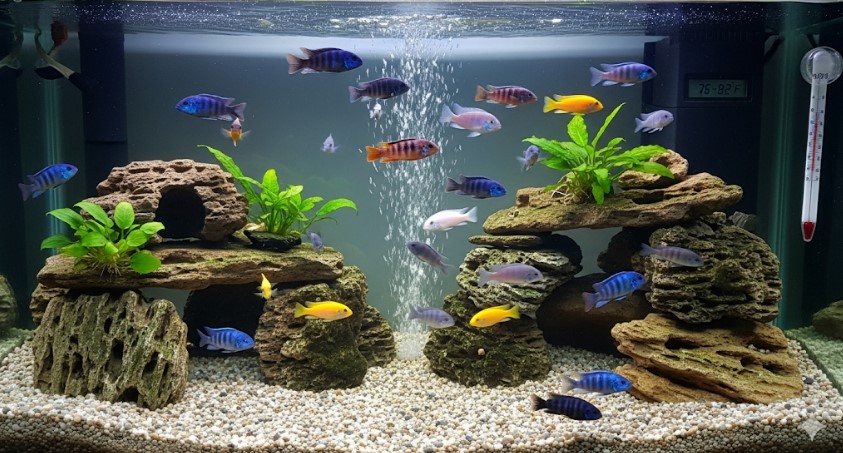
In order to get the best out of your cichlids’ color and behavior, their environment is important. Here’s what you need:
Ideal Tank Conditions
- Size: 55+ gallons for adult peacocks
- Substrate: Fine gravel or sand
- Décor: Caves and rocks for hiding
- Water Temperature: 76–82°F (24–28°C)
- pH: 7.5-8.5
- Water Hardness: Hard to moderate
Lighting
- Moderate to high (brites their colors)
- Avoid direct overhead lighting
Diet
- High-grade cichlid pellets
- Frozen or live foods (brine shrimp, bloodworms)
- Now and then vegetables (spinach, peas)
Maintenance
- Weekly water changes (20–30%)
- Consistent parameters to prevent stress or color loss
Do Different Types of Peacock Cichlids Have Different Temperaments?
Yes. While most peacock cichlids are very peaceful compared to other cichlids, some of the species, especially hybrids like OBs, tend to be more territorial or aggressive in nature. Temperament is based on:
- Genetics (wild vs. hybrid)
- Tank size and space
- Number of males vs. females
- Tankmate behavior
Tip: To minimize aggression, keep one male for every 3-4 females and do not overstock.
Emotional Reason Why People Love Peacock Cichlids
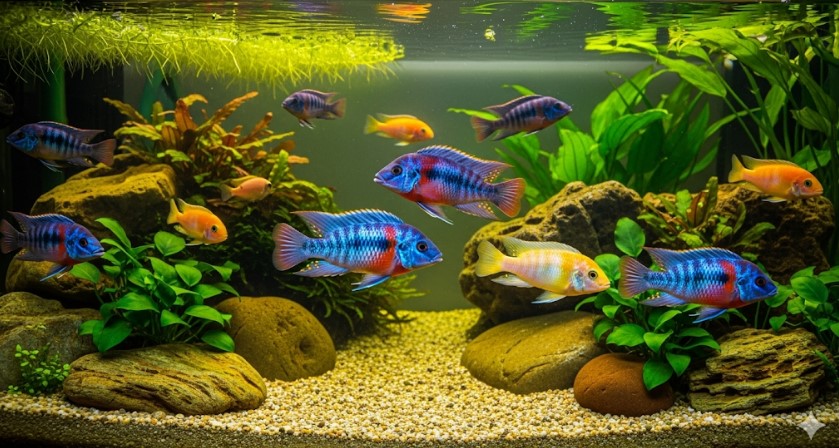
There is something mesmerizing about watching a brightly colored fish dart around the tank like a living gem. Peacock cichlids not only add loveliness: they add personality, calmness, and a touch of wonder to a room.
Whether you’re new to aquascaping or a seasoned expert, their presence can reduce stress levels and bring you closer to the natural world on a daily basis.
Are You Able to Combine Various Types of Peacock Cichlids Together?
Yes, but with caution.
Do’s:
- Select similar-sized species
- Match temperaments (docile with docile)
- Use sufficient hiding places
- Maintain adequate male-to-female ratio
Don’ts:
- Don’t crossbreed with very aggressive African cichlids
- Don’t overstock or under-filter
- Rare and Highly Sought Peacock Cichlid Varieties
Some of the peacock cichlid varieties that are rare include:
- Midnight Peacock
- Albino Firefish
- Blue Neon
- Sulfurhead hybrids
- Dragon Blood OB mix
These are precious because they are rare, rich in color, or have unique patterns. These typically cost more and may require professional care.
Do Peacock Cichlid Types With Photos Assist Identification?
Yes. Photographs with labels can assist in distinguishing:
- Color patterns (solid, blotched, striped)
- Fins (length, shape, and color)
- Eye color or body shine
- Distinctive markings (such as the yellow stripe of Sulfurheads)
Bring the Color of Africa to Your Aquarium
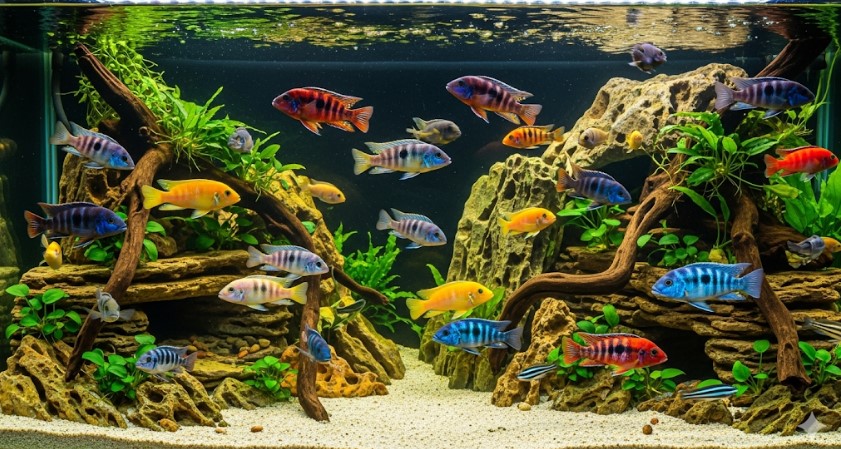
Peacock cichlids are not just beautiful fish: they’re works of living art. With lightning blues and burning reds, these fish enable aquarists to paint underwater pictures full of movement and personality.
By learning the different types of peacock cichlids, not only do you make informed choices, but you also provide your aquatic pets with an improved life. Whether you’re after uncommon varieties, vibrant hues, or serene community fish, there’s a peacock cichlid for every aquarium enthusiast.
Watch this space: we’re going to release special guides for each color morph soon, so that you can delve into their tales in even greater depth.
FAQs
What peacock cichlid type is ideal for newbies?
The Electric Blue and Sunshine Peacock are ideal for novices because they are so calm and tolerant.
How do you tell various peacock cichlid species apart by color?
By examining body color, fin color, head markings, and general pattern. Color is a big part of distinguishing each one.
Are all peacock cichlid species tank-compatible?
Generally, yes: but it’s important to match temperaments and avoid too many males. OB types can be more aggressive.
What is the rarest or most colorful peacock cichlid species?
The Midnight Peacock and some OB-Dragon Blood hybrids are among the rarest and most striking.
What is the difference between OB and regular peacock cichlids?
OBs are blotched, hybrid variations with mixed patterns. Regular peacocks typically have solid or consistent colors.
Are different peacock cichlids of different temperaments?
Yes. Most are peaceful, but hybrids such as OBs or Dragon Bloods may be more aggressive.
Which peacock cichlid variety grows the largest?
Sulfurhead Peacocks and Midnight varieties can grow up to 7 inches in huge tanks.
Are different varieties of peacock cichlids compatible?
Yes, but control aggression, tank size, and include hiding places.
What colors are various types of peacock cichlids available in?
Blue, red, yellow, orange, albino white, blotched patterns, and even deep blacks or purples.
Are hybrid breeds of peacock cichlids safe to have?
Yes, under proper care and tank management, hybrid peacocks are just as robust and gorgeous.

